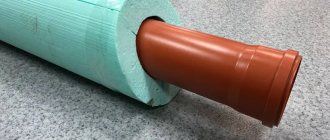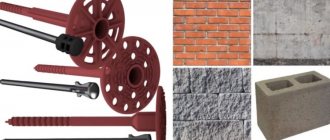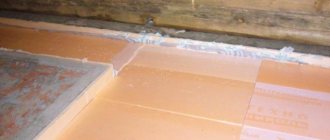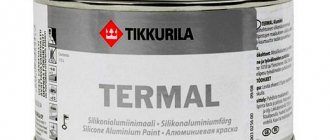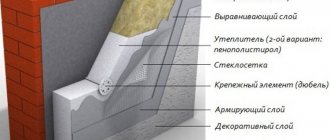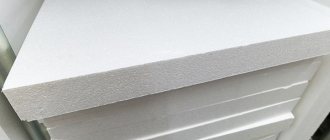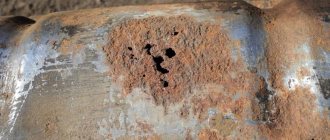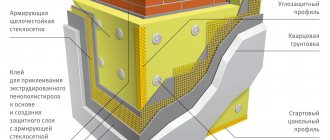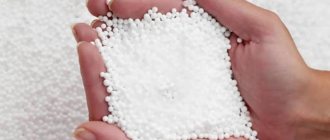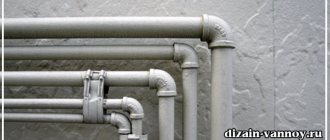Painting of foam plastic is carried out in order to protect the material from external influences (ultraviolet radiation, dust, dirt), increase the aesthetics of the finish and hide the joints between the slabs and elements. The main problem arises when choosing paint: not all compositions are compatible with the structure of polystyrene foam or have sufficient adhesion to its smooth surface. There are no specialized brands; most often, water-based or acrylic-based varieties are used, selected based on operating conditions. Maximum resistance to moisture is required for wet facades.
What paint can be used to paint polystyrene foam?
The main requirements put forward include:
- The absence of acetone, toluene, ethyl acetate and other organic solvents and ethers in the composition; any of these substances will corrode the foam and destroy its structure. For this reason, the material cannot be painted with alkyd paints.
- Good adhesion and elasticity. The cheapest and simplest oil paint, thinned with drying oil, is not suitable due to cracking after drying and peeling off from the foam.
- Resistance to precipitation for external surfaces, withstand wet cleaning for internal surfaces.
- Providing good protection of foam plastic from ultraviolet radiation and insolation (relevant for facades and areas near window openings).
- Sufficient coating density.
- Decorative effect, color preservation during operation.
The requirements are partially met by two types of paints: water-based and acrylic. The first variety is valued for its ease of application to foam plastic, vapor permeability and harmlessness, but due to its low resistance to moisture, it can only be painted on internal surfaces. Acrylic paints are more versatile, but their limitations include high price and fragility.
Which type is better to choose for interior work?
In this case, preference is given to affordable and harmless water-based brands; Snezhka, Dufa, Tikkurila, Caparol have the best reviews. They are applied in several layers (one is not enough, the structure will be visible) on the foam ceiling, wall panels and baseboards using a spray gun or brush and dry quickly without emitting an unpleasant odor. Water-based suspensions are quite attractive and do not fade.
To create a complex and multi-colored pattern, ordinary gouache is used; in this case, foam ceiling panels and decorative elements are decorated according to a template or painted individually. In this case, it is recommended to first paint the surface with one layer of water-based paint (to create a background and improve adhesion with the future pattern). Important nuances include the need to thoroughly dry each layer; foam itself does not absorb moisture, so the process takes a lot of time. Also, all joints and seams are covered with sealant.
It is recommended to paint areas exposed to intense moisture and contamination with expensive silicone compounds; they are better able to withstand frequent washing. Despite their high cost, they are chosen to protect foam panels or baseboards in bathrooms, kitchens and children's rooms. An alternative option is to cover it with acrylic paints: aerosols without freon from cans or regular brands. But it should be taken into account that such finishing needs frequent updating.
How and with what to paint polystyrene foam outside?
In this case, they stop at specialized brands for facades on a silicone or acrylic basis: Tikkurila, Terraco, Düfa. The finishing process becomes much more complicated if the foam is located outside; almost all weather-resistant paints in one way or another contain substances that destroy the structure. Simply painting it with moisture-resistant and safe acrylic is not enough: the seams and dowels will be visible, and the coating itself will not last long.
Painting a foam plastic facade is allowed only after sealing and finishing the joints with tape, applying a thin layer of plaster or treating the slabs with liquid glass. The minimum number of layers is 2.
Regardless of the location of the surface, polystyrene foam should be painted in conditions of normal or low humidity and at an air temperature of at least +15 °C. Preliminary cleaning of overly dirty areas with water is allowed, but finishing work begins only after they have completely dried. When painting foam plastic boards, it is advisable to choose a brand that does not require dilution; it is recommended to move it well using a construction mixer immediately before application. Any tinting or additives are administered in small doses.
When using a brush, it is necessary to paint polystyrene foam in one direction; for processing relief elements and large areas, it is better to choose a spray gun. The compositions are applied in thin, even layers (up to 2-3 times), each subsequent one after the previous one has completely dried. It is advisable to paint baguettes, complex decorative items and ceiling skirting boards made of foam plastic before installation, but in this case special attention is paid to the joints. When applying paint, it is recommended to hide wallpapered walls or other areas adjacent to polystyrene foam with masking tape. The last condition concerns time - the internal elements are updated at any convenient time, but the facades need to be painted before the start of winter.
Advantages of painted material
Polystyrene foam is a very popular material in construction; it is used for both external and internal work. However, after some time it may lose its attractive appearance. In addition, the initially white decor may not match the color scheme of the room. These reasons force craftsmen to paint materials in a shade suitable for the interior.
Due to the fact that some compounds can destroy the structure of polystyrene foam, before starting work it is important to figure out what paint to paint it with. Foam plastic will retain its attractive appearance for a long time if this work is done correctly. In this state it will have more advantages:
- it will be protected from moisture, dust, grease stains and other aggressive influences;
- polystyrene foam that turns yellow over time will not become noticeable under a layer of paint;
- painting will make everyday care easier;
- the decor will harmoniously fit into the design of the premises.
How to paint a concrete floor with polystyrene foam varnish - see in this video:
The material is very light and easy to work with, so it is used by professionals and home craftsmen. It is widely used not only in interior decoration of premises. Elements made of foam plastic often decorate the facades of buildings, gardening areas, and insulate the facades of buildings with slabs. With the use of coloring agents you can realize many original ideas.
A correctly chosen coloring composition can keep structures and decorative items beautiful and attractive for a long time. In this form, they will be less sensitive to sunlight and other destructive factors.
Why paint foam?
Foam-based products are used for both interior and exterior finishing and insulation work. It is used for heat and sound insulation of interior floors, partitions and walls, and in addition, many parts for decorating the interior of premises are produced from it. Often in the process of finishing work there is a need to paint polystyrene foam for one reason or another.
The first thing you need to think about is why paint polystyrene foam at all ? This operation is performed in two cases:
- Firstly, to create the effect of visual completeness and a holistic, harmonious interior, which consists of a combination of finishing elements, both among themselves and with the style of the room. It is unlikely that there will be connoisseurs of an interior in which white material with a bubble texture would be present as decor. Most, as a last resort, will prefer another type of finishing material that would fit more harmoniously into the decoration, please the eye and be combined with the surrounding environment. But polystyrene foam has too significant advantages over other finishing materials, especially in terms of price and ease of installation, that, as a rule, it is more rational to cover it with a paint coating than to look for a replacement in the form of another material.
- Secondly, a significant reason for painting is undoubtedly the need to protect it from the destructive effects of an aggressive external environment. For example, from exposure to bad weather in the form of precipitation, temperature changes, stormy winds and, ultimately, banal physical deformation of the material. All these factors seriously reduce the lifespan of foam products. As a rule, an unprotected foam coating very quickly, literally in one season, loses its original appearance.
Thus, applying paint and varnish to polystyrene material can be considered a logical continuation of finishing and decoration work.
Paint selection criteria
Foam products are sensitive to paints and varnishes. For this reason, you should carefully consider how to paint polystyrene foam so that it retains its appearance for a long time. Since this material does not tolerate acetone and other solvents, experts advise choosing water-based products. Such coatings are called water-dispersion. They can be:
Since foam does not tolerate solvents, the paint must be acrylic or water-based
- water-based;
- acrylic.
Any type of paint must meet basic requirements:
- it should fit well on the work surface;
- have high density and water resistance;
- be resistant to chemical influences.
All these parameters must correspond to the operating conditions of foam products.
However, not all foam items can be painted. The restriction applies, for example, to laminated plastic ceiling tiles. It just needs to be installed correctly, and it does not need painting.
Features of painting foam
For repair work, different types of foam are used. In this case they use:
- ceiling tiles made of foam plastic or polystyrene;
- skirting boards;
- decorative details;
- blocks for outdoor work.
Such products have a special composition that requires timely painting. Typically this procedure is carried out in the following situations:
- Design solutions. Foam plastic for decorating ceilings or baseboards does not always have to be white. The need to change the original shade may be associated with the desire to make the interior laconic or interesting. Painting also helps renew the surface.
- Elimination of irregularities. A negative characteristic of polystyrene foam is its fragility. After applying the dye, it is possible to eliminate dents from inaccurate fastening or other defects. Staining also helps make the joints less noticeable.
- Protection from the negative influence of external factors. Sun rays are especially harmful to polystyrene foam. Under their influence, premature appearance of yellowness is observed. Sharp temperature fluctuations lead to loss of insulation strength. The use of protective paints helps make the blocks more durable and ensures long-term operation.
Polystyrene foam is considered an affordable material, the disadvantages of which can be mitigated by a simple staining procedure. It is important to choose the right dye.
Characteristics of coloring compositions
The range of coloring products is quite large. According to experts, it doesn’t matter what kind of paint you use to paint the foam, as long as it is water-based. This is due to the fact that the type of polymer almost does not reflect its properties. However, in order for the painting to be done efficiently, you should know the advantages and disadvantages of the compositions used.
The best paint option for polystyrene foam is acrylic.
Among the water-dispersed group of paints, acrylic paint has performed very well. This coating has the following positive properties:
- reliable protection against ultraviolet radiation;
- long service life;
- dries quickly and has no odor;
- health safety;
- ease of application;
- easy to clean if necessary;
- resistance to pollution;
- the composition is not affected by high temperature;
- a wide variety of shades.
Painted foam is easy to clean
In addition to the listed advantages, this coloring material has the only drawback - it is high cost. However, it is fully justified by significant advantages. A high-quality composition cannot be too cheap.
In addition to acrylic paints, you should pay attention to water-based coatings. They also have good properties. Among the advantages:
- environmental friendliness;
- lays down smoothly and has no odor;
- good vapor permeability;
- large color palette;
- average cost.
Indoor work
The process of coloring foam products consists of several stages. Before you paint the foam, you need to prepare it. A primer is used for this. An aerosol composition is best suited for this purpose; it is simple and easy to apply to the desired object, the surface dries quickly and can be ready for subsequent work in a short time. This product is ideal for priming the desired element indoors.
Before you start painting parts, you need to prime them with an aerosol composition.
At the very beginning of work, you need to clean the surface with a damp cloth and wait until it is completely dry. When using an aerosol primer, it is recommended to shake the bottle for a few minutes before application and then coat the material with it.
The composition is sprayed quickly, applying a thin layer at a distance of 20 cm from the product. 3-5 layers of primer are enough to get a high-quality coating. After this, the material must dry completely. This takes approximately 30-30 minutes. Various irregularities or drips can be removed with a spatula, lightly touching the surface.
PROCESSING FOAM FOR THE PRODUCTION OF PACKAGING, FACADE DECOR TO ORDER!
Visit to the client FREE*
*Across St. Petersburg and the region. When traveling to other regions, please contact our managers
Packaging development FREE**
**For more information, please contact managers
Sample for testing FREE***
***Depends on the material and circulation. For more information, contact the managers
PHOTOS OF OUR PROJECTS
Catalog
Presentation of packaging
ORDER
Any questions left ? Application processing 15 minutes
Sequence of actions during operation
To paint the outside and inside, select the desired type of composition. After choosing, you can start painting the product yourself. The easiest way to do this is to use a product in an aerosol package.
To paint polystyrene foam with your own hands, it is best to choose spray paint
Before starting work, shake the can for 1-2 minutes and then evenly cover the surface from a distance of 30 cm in 2-3 layers. Each time it must dry and only then can the next layer be applied. This method is considered the simplest if you learn how to work with a cylinder.
If the composition in a jar is used, painting is done using a brush or roller. The required amount of water is added to the paint to achieve a suitable consistency. If several tones are used, the composition should be mixed well before coating to obtain an even color. If the elements are painted in different colors, then the brush must be rinsed well with water each time.
To consolidate the result, you can use varnish. A special water-based varnish is often used in combination with acrylic paint to further protect the surface of the foam.
Ways to paint polystyrene foam for fishing: creating balls
Foam balls are used for fishing as bait. They can be painted in different colors. The need for painting is a controversial issue. Many people consider this action optional.
Each angler determines the need for painting independently, based on his own experience.
Painting the bait is done in several ways. This is how a permanent marker, a water-repellent felt-tip pen and a special aerosol are used. Working at home will cost more than buying ready-made bait. This process requires labor and time resources. That is why most fishermen buy ready-made balls and do not wonder how to paint the foam.
In addition to painting, you will have to add flavoring to the balls. To do this, the balls are sprayed with special aerosols. You can soak the foam in solutions with the addition of vanilla or garlic, dill, or cilantro. Such balls will be attractive to fish and guarantee a good catch.
Additional painting tips
To avoid leaving streaks on the foam, move the brush in one direction. The purchased material for painting must have a high adhesion coefficient. In this case, it will easily lie on the material.
To paint foam plastic, you need to have two brushes, wide and thin.
If the paint contains solvents that are hazardous to polystyrene foam, then a layer of plaster should be applied to the surface to be treated. It will serve as protection against destruction.
For better quality painting, it is better to have two brushes: a flat one 4-5 cm wide and a thin round one for processing small details.
When working outdoors, paint should not be used if the temperature drops below +15 o C. The quality of the coating will be negatively affected by high humidity. It is advisable to use only waterproof material.
Acrylic paint cannot be used in low temperatures and high humidity.
Acrylic compounds tend to bubble if they are applied in a thick layer. Over time it will begin to fall off. Experts recommend using paints that are completely ready for painting. They will make the work easier for those who do not have the necessary experience in this matter and will help to obtain a high-quality result.
The process of painting foam plastic has many subtleties and pitfalls. However, following these tips, a home craftsman will be able to carry out painting efficiently and quickly.
Selecting colorants for polystyrene foam is a particularly difficult task. After all, this type of material does not tolerate contact well with organic solvents, on the basis of which most paint and varnish compositions are created. If we take into account the characteristics of polystyrene foam and the composition of the materials that create the decorative coating, painting polystyrene foam occurs quickly and efficiently.
Popular paint and varnish compositions
The market offers a large selection of products that are widely used in exterior and interior work. But not every option is suitable for this purpose. Still, how to paint polystyrene foam? Let's look at each option in more detail:
- alkyd. To achieve optimal consistency, the paint is diluted with acetone, white spirit or solvent. Such components destroy the protective layer of polystyrene foam, making it unusable. Therefore, the option is categorically not recommended for use in this case;
- oil Drying oil is used in the production of paints. It does not have a negative effect on the surface of the panels, but its structure does not allow achieving the appropriate decorative effect. In this case, a “vitreous” coating is expected to appear. In addition, it has low strength;
- water-based. The products do not contain organic solvents. Therefore, water-based paint is considered the best option for creating a durable decorative coating. In addition, the acrylic pigments present in the composition have good adhesive properties. But when performing repair work, it is worth considering the type of material, since paint for external and internal work is produced separately.
Also suitable for this purpose is the use of acrylic aerosols that do not contain freon. If the finishing work is carried out correctly, the durability of such a coating is ensured. But unlike water-based paints, aerosols are more expensive.
What is the difficulty of painting foam?
Before you try to paint a foam product with your own hands, you need to find out what features distinguish the material from which it is made, and how it reacts to certain paints and varnishes. Polystyrene foam has a porous structure and extremely low density. Simply put, it's very fragile.
For this reason, products made from it must be painted carefully so that they do not crumble or break.
As for the choice of paints and varnishes, you need to be careful here. It is necessary that the paint components do not damage (corrode) the surface of the foam object.
Stages of work
A step-by-step work diagram is presented using the example of painting the facade of a building. In this case, all existing nuances and aspects will be affected, since the facade is regularly exposed to ultraviolet rays, precipitation and temperature changes in spring and autumn.
After the panels are fixed to the outside of the walls, you can begin to work, namely, to create a high-quality base for paint. The following work steps must be completed:
- surface leveling. It is necessary to make the existing joints as invisible as possible, and also to level the areas where the dowels were located;
- cleaning It is necessary to remove accumulated dust and dirt from the surface. Otherwise, the adhesive properties of the soil composition will be lower than expected;
- primer. For this you can use a regular acrylic composition. The primer is poorly absorbed into the surface of the panels, so during the work, characteristic smudges may form, which will subsequently need to be removed with a spatula, otherwise, when creating a decorative coating, the paint will repeat the relief of all the formed drops.
Preliminary work allows you to create a durable and uniform surface without protrusions and gaps. Once all steps have been followed, you can begin painting. The process itself is quite easy. If you have the necessary tools, it can be performed by a person without the appropriate education.
Required Tools
To work you need to buy:
When painting a large area, it is appropriate to use a special device - a spray gun.
The material must be given the appropriate shade and poured into a pre-prepared bath. Using a roller, the decorative coating is applied to the wall surface. The tool must be operated correctly. The roller should move in one direction, namely, down-up. Such movements help minimize the appearance of streaks on the surface.
After the first layer has dried, you need to paint the walls again in the same color. Compliance with the stages of work involves creating a beautiful and uniform coating with a perfectly even tone.
Our company sells materials for thermal insulation. The catalog contains high-quality and highly technical products. Here you can choose materials for insulating buildings for different purposes.
